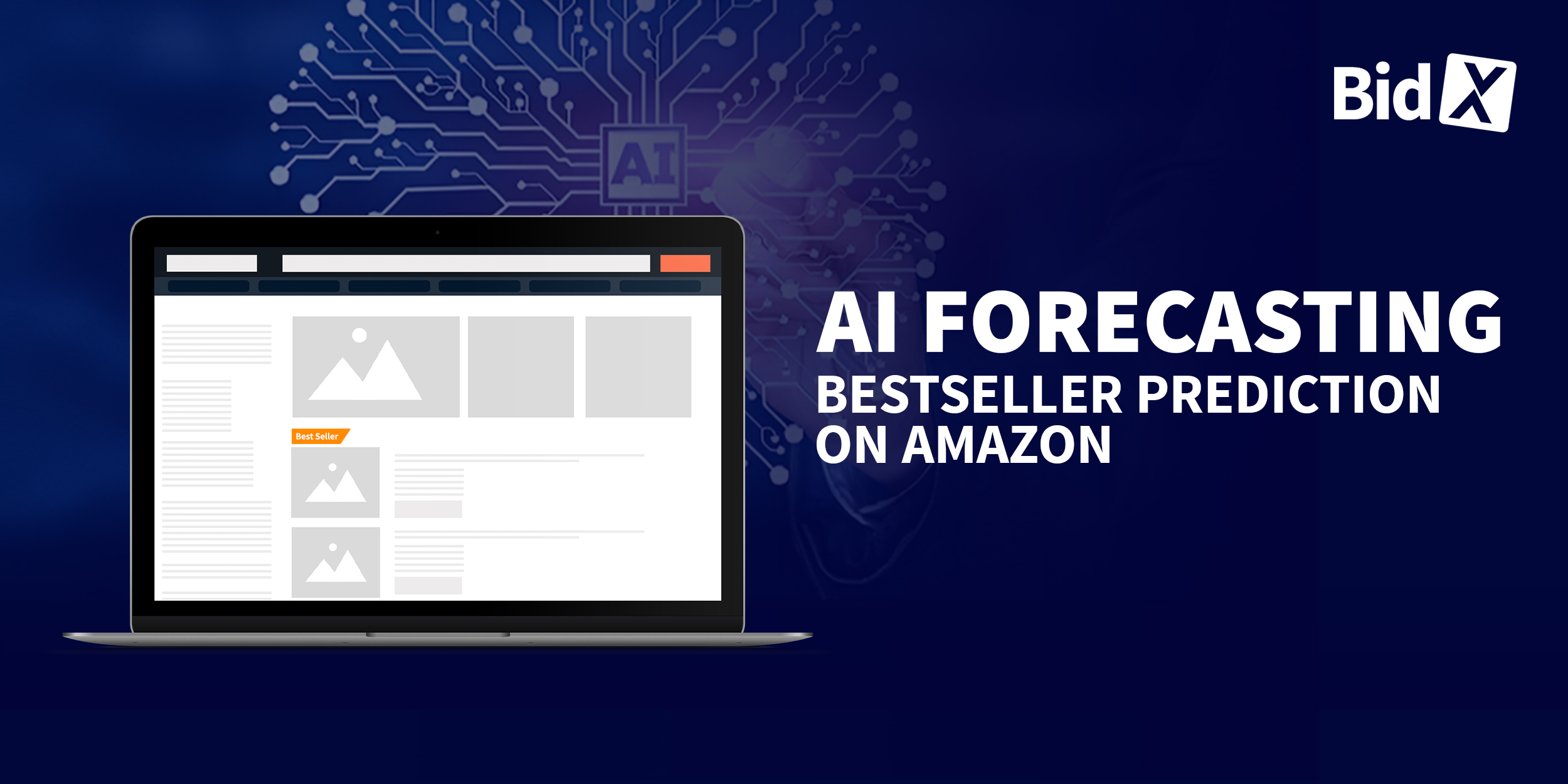AI forecasting: Bestseller prediction on Amazon through data analysis
In the fast-moving world of e-commerce, identifying trends early is crucial. But how can companies be proactive in a market that is constantly changing? The answer lies in technology. With the rise of artificial intelligence (AI) and machine learning, brands now have powerful tools at their fingertips to extract insights from vast amounts of data. These technologies can identify hidden patterns to make accurate predictions about future bestsellers. In this post, we dive into the world of data analytics and AI to understand how they work together to predict tomorrow's bestsellers on Amazon.
Table of contents:
- The importance of data in e-commerce
- Basics of machine learning and AI in e-commerce
- Prediction of best sellers on Amazon
- The role of AI in predicting Amazon best sellers
- Conclusion
- FAQ
The importance of data in e-commerce
In the digital landscape, data is the fuel that drives online commerce. It provides deep insights into customer behavior, market trends and business performance. By collecting, analyzing, and interpreting this data, companies can make informed decisions that increase revenue and strengthen their market position. But which data sources are most relevant and how can they be used effectively?
While this article focuses on predicting best sellers on Amazon, there are other ways to make money on the platform. Learn more about how you can make money on Amazon without selling physical products in this article.
Data sources and their relevance
In the world of e-commerce, there are a variety of data sources that companies can use to gain valuable insights. One of the most important sources is customer reviews. These direct feedbacks offer insights into customer satisfaction and preferences. Positive reviews can drive sales of a product, while negative reviews provide clues to areas for improvement. Sales figures are another crucial data point. By analyzing them, companies can identify bestsellers, uncover seasonal trends, and adjust their marketing strategies accordingly. Finally, search queries are also invaluable. The search terms entered by customers on platforms show what they are looking for and which products or categories are trending, which helps optimize the product catalog and increase visibility.
Advantages of data analysis in online commerce
Data analytics in e-commerce offers a wealth of benefits that go far beyond simple sales figures. A key element is the ability to create personalized customer experiences. By understanding customer preferences based on their buying behavior and interactions, companies can create tailored product suggestions and marketing campaigns that increase customer loyalty.
Another benefit is efficient inventory management. With accurate sales forecasts, companies can plan inventories better, avoiding over- or understocking. Finally, data analysis also enables optimized pricing. By monitoring sales figures in combination with competitive prices, companies can flexibly adjust their pricing strategies to maximize profitability and remain competitive.
Basics of machine learning and AI in e-commerce
For Amazon sellers, machine learning and artificial intelligence (AI) are critical tools for predicting bestsellers and driving sales. These technologies make it possible to analyze customer behavior, optimize product strategies and predict future sales trends. But how do they work and how can retailers use them?
What is machine learning?
Machine learning is an area of artificial intelligence that allows computers to learn from data and make predictions without being explicitly programmed. For Amazon merchants, this is particularly valuable as they process vast amounts of data, from customer reviews to sales histories. Through machine learning, for example, retailers can identify buying patterns to predict which products might be popular in the next season. Another use case is price optimization: algorithms can analyze historical sales data and recommend prices to maximize sales. In the following section, we look at a practical example of this.
Practical example: Dynamic pricing
One challenging aspect for Amazon sellers is the pricing of their products. With thousands of competitors offering similar or identical products, the right pricing strategy can make the difference between a successful sale and an overlooked product.
This is where machine learning comes into play. Some sellers use algorithms that constantly monitor competitors' prices for similar products. These algorithms can then suggest the optimal selling price for a product based on historical sales data and current market conditions.
For example: If a merchant sells a particular smartphone accessory and the algorithm determines that competitors have lowered their prices by 10% and at the same time demand for that accessory is increasing, the algorithm might recommend that the merchant lower its price by a certain percentage to remain competitive and maximize sales.
By using such dynamic pricing systems based on machine learning, Amazon merchants can adjust their prices in real time to gain a competitive advantage.
AI models and their application
There are several AI models that Amazon merchants can use to optimize their sales strategies:
Neuronal networks: These models are particularly powerful at processing large amounts of data and can be used to identify complex buying patterns. For example, they could be used to predict which products may be purchased together based on historical data.
Decision trees: These models break down data into subgroups and can help understand customer preferences. A retailer could use them to find out which product features are most popular with certain customer segments.
Clustering: Here, similar data points are grouped together. A retailer could use this model to identify products that are often purchased together, creating product bundles or discount promotions.
Challenges and limits
Despite the benefits of AI and machine learning, there are also challenges that Amazon merchants should be aware of:
Data quality: Inaccurate or incomplete data can lead to incorrect predictions. It is important that traders ensure that their data is clean and up-to-date.
Overfitting: A model that is too tailored to specific data may have problems when applied to new data. Traders should regularly train their models with new data.
Ethics and data protection: When analyzing customer data, retailers must ensure that they comply with data protection regulations and take ethical considerations into account.
Complexity: Some AI models can be very complex and require a deep understanding to be used effectively. It may be useful to consult experts or take training courses in this area.
Prediction of best sellers on Amazon
Amazon, as the leader in e-commerce, is a battleground for merchants struggling to get their products into the customer's focus. In this highly competitive environment, the ability to predict future bestsellers can mean the difference between success and mediocrity. Machine learning and AI provide tools to help retailers identify the next big hits on Amazon and adjust their strategies accordingly.
How Amazon’s algorithm works
Amazon's ranking algorithm, often referred to as the A9 algorithm, is at the heart of determining which products appear at the top of search results. This sophisticated algorithm considers a variety of factors to determine a product's relevance to a particular search query.
It is important that the product title, description and keywords must match what the user is looking for. But relevance alone is not enough. The algorithm also takes into account the sales history of the product. Products that have sold well in the past, especially those with a high click-through rate and conversion rate, are preferred. Customer reviews also play a crucial role.
Products with positive ratings and an overall high number of reviews are ranked higher. Finally, the price of the product also has an influence. A competitive price, especially when combined with other positive factors such as quality and good reviews, can significantly increase a product's visibility. By understanding and adapting to this algorithm, Amazon merchants can optimize their product listings and increase their chances of ranking high in search results.
AI-driven trend forecasting tools
In the ever-changing landscape of e-commerce, especially on a dominant platform like Amazon, the ability to predict future sales trends is invaluable. That's where AI-driven tools come in, aimed at giving Amazon sellers that critical edge. These tools use machine learning to analyze vast amounts of sales data, identify patterns, and make informed predictions about potential bestsellers.
But predicting trends is only one piece of the puzzle. Pricing plays an equally important role in a seller's success on Amazon. AI-driven price optimization tools that take into account current market conditions, historical sales data, and competitor pricing can suggest to merchants the optimal selling price for their products.
In addition, efficient inventory management is critical for Amazon sellers. AI-driven inventory management tools analyze sales trends, account for seasonal fluctuations, and estimate delivery times to help merchants maintain proper inventory levels and avoid overstocking. Overall, these AI technologies provide merchants with the insights and tools they need to succeed on Amazon.
Practical application and case studies
The application of AI and machine learning in the context of Amazon has already led to impressive success stories:
Case study 1: An outdoor gear seller used AI-driven market analysis tools to identify emerging trends in camping. This led to the launch of a new, innovative camping stove that became a bestseller within months.
Case study 2: A bookseller used price optimization tools to dynamically adjust the prices of its books. This led to a 20% increase in sales within one quarter.
Case study 3: A fashion merchant uses inventory management tools to optimize its stock levels based on seasonal trends and sales forecasts. This reduced overstocks and increased profitability.
These examples show how the proper application of AI and machine learning can help retailers effectively position their products and succeed on Amazon.
The role of AI in predicting Amazon best sellers
Predicting bestsellers on Amazon goes beyond pure intuition. With the power of AI, retailers can analyze and leverage data on an unprecedented scale to make informed predictions. In this section, we explore how AI is specifically used to maximize the chances of a bestseller.
AI-driven analysis of customer ratings and feedback
Analyzing customer reviews can be a complex process, especially when considering thousands of feedbacks. AI tools use techniques like sentiment analysis to determine the overall sentiment in reviews. They can identify positive, negative and neutral comments, and even filter out specific topics or issues that are frequently mentioned. For retailers, this means they can quickly respond to customer concerns or improve their products based on feedback. Strategically, retailers can use this information to optimize product descriptions, answer frequently asked questions, or adjust their customer service strategy.
Predicting seasonal trends with AI
Historical sales data often contains patterns that indicate recurring seasonal trends. AI algorithms can analyze this data and create predictive models that indicate when sales are likely to rise or fall. For example, an algorithm might predict that sunscreens will be in high demand in the summer or electric blankets in the winter. Retailers can use these predictions to replenish their stock in advance, plan advertising campaigns or organize discount promotions.
AI in advertising and product placement
Proper product placement and effective advertising are critical to success on Amazon. AI can analyze data from previous advertising campaigns to determine which strategies have the highest conversion rate or the best ROI. For example, an AI model might determine that products advertised between 7 p.m. and 9 p.m. have a higher click-through rate. Retailers can use these insights to allocate their advertising budgets more efficiently and ensure their products are in the right place at the right time.
Competitor analysis through AI
In an environment as competitive as Amazon, it's critical to stay one step ahead. AI tools can continuously monitor competitors' product listings, prices and promotional strategies. For example, if a competitor lowers the price of a similar product, the AI system can automatically notify the retailer, who can then decide whether to adjust its own price. In addition, such tools can identify market trends by analyzing the movements and strategies of top sellers so that retailers can adjust their own strategies accordingly.
Conclusion
In today's e-commerce environment, competition is more intense than ever, especially on platforms like Amazon that are used by millions of merchants. In this environment, the ability to predict future bestsellers and proactively adapt to market changes can mean the difference between success and mediocrity.
Machine learning and artificial intelligence have proven to be invaluable tools for Amazon merchants. They provide deep insights into sales data, customer behavior and market trends. By leveraging these technologies, merchants can optimize their product strategies, set competitive prices, and implement more efficient inventory management practices.
However, it is important to emphasize that technology alone is not enough. A deep understanding of the market, continuous education, and a willingness to adapt to change are equally critical. AI and machine learning are tools that, when used properly, can help merchants achieve their goals and succeed on Amazon.
For those in the e-commerce space, or planning to be, now is the time to learn about these technologies and integrate them into their business strategies. The future of online commerce will undoubtedly be driven by data, and those who can use this data effectively, especially with the help of AI, will be at the forefront in the future.
FAQ
What exactly is the difference between machine learning and artificial intelligence?
Artificial intelligence (AI) is a broad field of computer science that aims to create machines that exhibit intelligent behavior. Machine learning (ML) is a subfield of AI that involves developing algorithms that enable computers to learn from data and make predictions or decisions without explicit programming.
How do I get started using AI tools as an Amazon merchant?
The first step is to research and select appropriate AI tools tailored to your specific needs. Start with tools that provide simple analysis and prediction, and expand your tool palette as you get more comfortable and want to increase complexity.
Are AI tools expensive to purchase and use?
The cost of AI tools varies depending on functionality and provider. There are both free and paid tools. Many vendors offer tiered pricing models so you can start with basic features and upgrade to advanced features as needed.
How secure is my data when I use AI tools?
Privacy and security are key concerns when using AI tools. It's important to choose tools from trusted providers that have strict privacy policies. Always read the privacy policy and make sure your data is encrypted and stored securely.
How long does it take to see results after I implement AI tools?
The time to see results varies by tool and use case. Some tools can provide instant insights, while others, especially those based on machine learning, require time to learn from data and make accurate predictions.
About the author
Florian Schneider is a long-time e-commerce merchant and expert in building brands on Amazon. He also offers strategic consulting around e-commerce topics for digital startups and companies. On his blog, he writes about insightful content related to online entrepreneurship with a focus on e-commerce and digital marketing.





